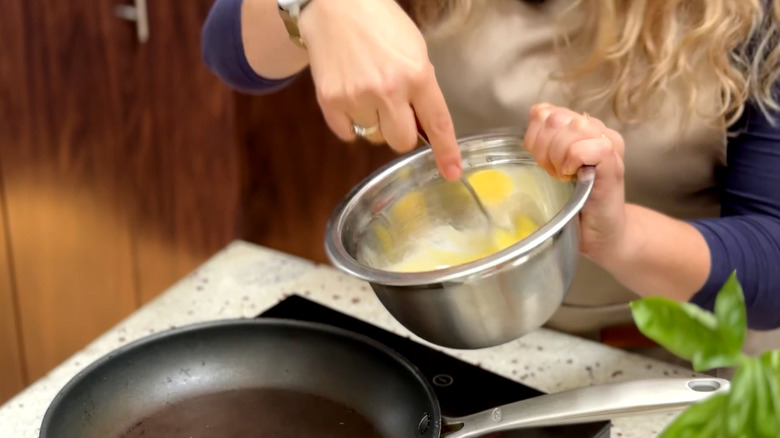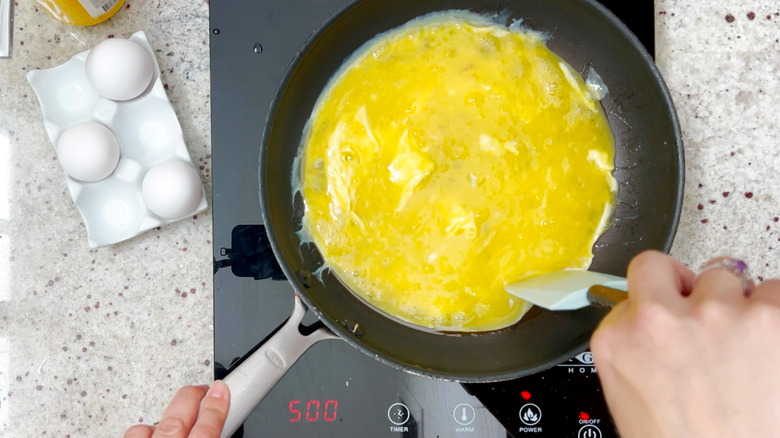How To Make An Omelet - You're Doing It All Wrong
The French omelet, when done properly, can be sheer perfection with its pillowy exterior, a custard-like interior, and the inclusion of few other simple ingredients like cheese and herbs that combine to become greater than the sum of their parts. But getting there isn't as simple as it seems. As Chowhound recipe developer Ksenia Prints points out in this "You're Doing It All Wrong" video, the French omelet is the "grand old daddy of every culinary school graduate" because of the skills needed to create it. While there are many styles of omelets that are worth learning to make (and quite tasty), the French omelet is a culinary standard and a recipe that every home cook should have in their repertoire.
Perfecting the necessary techniques for this dish will help take you to the next level — not just with this classic, but with cooking in general. As Prints explains, the common mistakes people make when cooking an omelet involve the pan's temperature, not properly mixing the eggs, choosing the wrong butter or oil, and not using the proper techniques for cooking and rolling the omelet. But, once you've learned these few steps, you'll end up with a delicious yet simple meal, and important skills you can use for many other dishes.
Go low, use a fork, and stay away from cold butter
The first mistake you may be making is having your burner up too high. Ksenia Prints suggests using the medium-low setting. "Err on the side of low because you really want to keep your eggs yellow, and nice and quivery and gooey," she says. "And you don't want that browning on the outside."
Choosing the right amount of eggs to use is also important. Prints recommends using three eggs for an omelet, and warns that more than four eggs can make the omelet difficult to manipulate in the pan.
As for mixing your eggs, ditch your whisk and use a fork instead. "A whisk is going to get you the effect of a soufflé, while a fork gets enough air — but not too much air — so that your eggs are cohesive and homogeneous but not too fluffy," Prints says. You'll know the eggs are properly mixed when there's no separation between the yolk and the white of the eggs, and you get strings of eggs coming off your fork when you lift it from the bowl.
Choosing your butter or oil is also paramount for the perfect omelet. Most importantly, don't use butter straight from the fridge. Prints explains that cold butter won't evenly distribute the heat. Instead, Prints uses ghee (also known as clarified butter), because she says, "It's going to melt just right."
Keep your eggs moving but be gentle
Once the pan is heated and the ghee has been evenly distributed across its surface, add the eggs. But watch out — if your eggs sizzle when they hit the pan that indicates the pan is too hot.
The next mistake to watch out for is in your actual cooking technique. After salting the eggs, instead of furiously mixing your eggs around the pan, use a spatula to gently scramble the middle of the omelet while lightly moving the pan back and forth. "The key to a French omelet is to keep that nice gooey center," says Ksenia Prints. As the sides set, push the eggs towards the center of the pan and keep an eye on the heat. "Making an omelet is not a sprint," Prints says. She also recommends tapping your pan on the counter to break up any air bubbles that have formed, which can cause brown spots on the omelet.
Once the eggs have set at the edges, it's time to add the cheese — Prints uses a combination of shredded cheddar, mozzarella, and Parmesan — and roll your omelet. At this point, if your eggs are sticking to the pan at all, you should add more ghee. When your eggs come loose from the pan, use the spatula to roll the omelet three times. After you've plated your omelet, you can top it with more Parmesan and some chives for a bit of bite. Voila! These omelet tips will change the way you cook forever, so get cracking.

